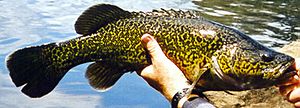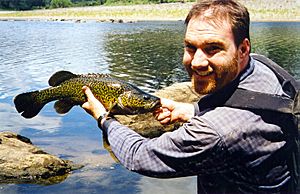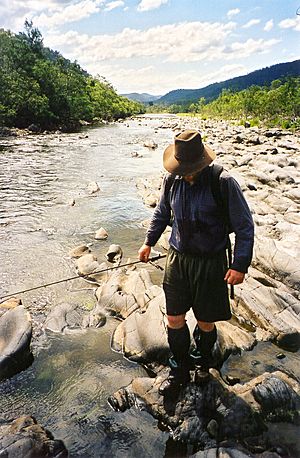Eastern freshwater cod facts for kids
Quick facts for kids Eastern freshwater cod |
|
|---|---|
 |
|
| Conservation status | |
| Scientific classification |
The eastern freshwater cod (Maccullochella ikei), also known as the eastern cod or Clarence River cod, is a large fish that lives in fresh water. It's a type of cod found in the Clarence River system in north-eastern New South Wales, Australia. These fish are close relatives of the famous Murray cod from the Murray-Darling River system. Many people see them as a special symbol of the Clarence River.
Eastern freshwater cod live for a long time and grow slowly. Sadly, they are an endangered species. This means their numbers are very low. They are threatened by illegal fishing, damage to their homes (habitat), big natural events like bushfires, and problems from having too little genetic variety. Because they are endangered, they are protected by law. No one is allowed to catch or harm them.
Contents
Where Do Eastern Cod Live?
Eastern freshwater cod are originally from the Clarence River system in northern New South Wales, Australia. The Clarence River is a very large river on Australia's east coast. It has many smaller rivers and streams that flow into it. Compared to other Australian rivers, the Clarence River and its main branches, the Mann and Nymboida Rivers, are huge and carry a lot of water.
These cod used to be found in large numbers throughout the entire river system, even high up in the mountains. However, they were not found above very large waterfalls in some areas.
There used to be a similar cod population in the Richmond River system, called the Richmond River cod. These fish are now extinct. People have tried to put young cod from the Clarence River into the Richmond River. But so far, there's no sign that these fish are breeding there. Another related cod, the Brisbane River cod, also used to live in the Brisbane River system but is now extinct.
What Do Eastern Cod Look Like?
The eastern freshwater cod is a medium-sized fish that looks a bit like a grouper. It has a deep, long body that is round. Its head is wide and scooped, and it has a big mouth. Inside its mouth are many very small, needle-like teeth. Its upper and lower jaws are usually the same length, or the lower jaw might stick out a little. Their eyes are a bit bigger and stand out more than those of the Murray cod.
Their top fin (dorsal fin) has sharp spines and is partly separated from a taller, rounded soft fin. The soft dorsal fin, the fin on their belly (anal fin), and their tail fin are all large and rounded. They are usually dark grey or black with clear white edges. Their large, rounded side fins (pectoral fins) are often the same color as their body. The fins on their underside (pelvic fins) are large and angled. They are placed forward of the pectoral fins and are usually a see-through greyish-white. In bigger fish, these fins become less see-through. The front greyish-white rays on their pelvic fins split into two long, thin parts. These parts are much longer than those on a Murray cod.
Eastern freshwater cod can be cream, greyish-white, or yellow on their bellies. Their backs and sides are usually a bright yellow or gold. They have a thick pattern of black to very dark green spots and blotches. This gives them a marbled look, sometimes like a leopard's spots. However, their colors can change a lot. Cod from dark, shady places can be very dark or almost black.
Historically, eastern freshwater cod were recorded to be over 1 meter (3.3 feet) long and weigh up to 48 kilograms (106 pounds). But today, they are usually less than 60 centimeters (2 feet) long and weigh less than 5 kilograms (11 pounds). It's rare to see a very large one now.
Where Did Eastern Cod Come From?
Eastern freshwater cod are a type of cod that came from the Murray cod. Murray cod live in rivers on the western side of the Great Dividing Range. Scientists believe that Murray cod entered an east coast river system, probably the Clarence, a long time ago. This happened between 0.62 and 1.62 million years ago. This was likely due to a natural event. Over time, these cod became separated from the Murray cod populations. Because of this, they slowly changed and became a new species.
Besides the eastern freshwater cod in the Clarence River, cod were also found in other coastal river systems. When Europeans first arrived in Australia in the 1700s, cod were common in four East Coast river systems:
- Clarence River system, northern New South Wales (eastern freshwater cod, Maccullochella ikei)
- Richmond River system, northern New South Wales (Richmond River cod, Maccullochella ikei)
- Brisbane River system, southern Queensland (Brisbane River cod, Maccullochella sp.)
- Mary River system, central Queensland (Mary River cod, Maccullochella mariensis)
Studies of their DNA show that eastern freshwater cod and Mary River cod are more closely related to each other than to Murray cod. This suggests that Murray cod only crossed into east coast rivers once. It's not clear which river system was the first entry point. But some evidence suggests it was the Clarence River.
Scientists think that Murray cod crossed the Great Dividing Range in a few ways. One way is "river capture." This is when the top part of an east-flowing river slowly cuts back and "captures" the top part of a west-flowing river, along with its fish. Another way is a "wet divide." This is when extreme floods or a very wet climate created swamps that connected the top parts of western and eastern rivers.
After crossing the Great Dividing Range, drops in sea level during ice ages or other river capture events connected these four coastal rivers at different times. This allowed freshwater cod to spread and live in these rivers. The genetic separation between Mary River cod and eastern freshwater cod is estimated to be only 300,000 years.
DNA analysis also shows that eastern freshwater cod in the Clarence River system went through times when their population dropped very low before Europeans arrived. This was probably due to severe droughts, huge bushfires, and many fish dying from ash in the water. Even though their numbers recovered before European settlement, the species lost some of its genetic diversity. More genetic diversity was lost when European settlers caused big declines in their numbers.
What Do Eastern Cod Eat and Where Do They Live?
Eastern freshwater cod are found in clear, flowing rivers and streams. These places often have rocky bottoms and deep pools. They live in all sizes of rivers and streams within the Clarence River system, even high up in the mountains. Eastern freshwater cod are very territorial and can be aggressive.
Most of their food comes from crustaceans (like large, clawed Macrobrachium shrimp and small, clawless Paratya shrimp) and other fish. But they are strong hunters and will eat many other things. They are known to eat insects (like cicadas), frogs, snakes, lizards, birds, and even small mammals.
Eastern Cod Life Cycle
Eastern freshwater cod grow at different rates, but generally slower than Murray cod. The oldest one ever studied was only 14 years old. However, this is likely because of limited studies and many years of overfishing and illegal fishing. These activities have caused most large fish to disappear. It's very likely that this species can live as long or even longer than Murray cod, which can live up to 48 years.
Eastern freshwater cod become ready to breed at 4 to 5 years old. They can be as small as 700 grams (1.5 pounds) when they start breeding. This is much smaller than Murray cod. This seems to be a special adaptation to the rocky, low-nutrient, and often small waterways where they live. The trout cod, another type of Maccullochella cod, which once lived in similar places in the Murray-Darling system, also shows this trait.
Eastern freshwater cod lay their eggs in early spring when the water temperature goes above 16°C (61°F). They use rock structures as places for their sticky eggs. Most other parts of their breeding, like the male fish guarding the eggs and newly hatched babies, are similar to Murray cod. The breeding season lasts 8–10 weeks. Males clean and protect the nesting spots until females come in and perform a special breeding ritual. The males then protect the eggs until they hatch. They continue to defend the young fish for 12–14 days until they swim away.
It is against the law to specifically fish for this protected species. It's also important for anglers (people who fish) to avoid accidentally catching eastern freshwater cod in winter when they are developing their eggs. They should also avoid catching them in early spring when they are spawning. Research shows that catching them at these times can cause the fish to reabsorb their eggs or abandon their nests. If a nest is abandoned, the eggs are quickly eaten by shrimp, turtles, and small fish. To prevent this, there is a total fishing ban on the Mann and Nymboida Rivers and their smaller streams between August and October each year.
Protecting Eastern Cod
After their numbers and where they live greatly declined, the eastern freshwater cod is now listed as endangered by the IUCN.
Why Their Numbers Dropped
Old records show that eastern freshwater cod were extremely common in all parts of the Clarence River system when Europeans first settled there. They were so common that people could catch them "on demand" for diners at a riverside hotel. They were even reportedly used to feed pigs, just like the related Mary River cod.
Several things have caused the decline of eastern freshwater cod. One big reason was many years of heavy overfishing. People used lines, nets, explosives, and spears to catch them. Eastern freshwater cod grow very slowly and don't have many babies. This makes them even more vulnerable to overfishing than Murray cod.
Another factor was several huge bushfires that covered entire river areas in the 1920s and 1930s, especially one in late 1936. These fires caused many fish to die from severe and widespread ash pollution in the first rain after the fires.
Damage to their habitat and silt (mud and dirt) filling up the rivers also harmed them. This was caused by poor farming practices, like clearing trees and plants along riverbanks and letting farm animals walk all over the river banks. Some of these practices that lead to land degradation are still happening today.
Pollution from Mining
Tin mining and digging for tin caused serious and widespread pollution in the Clarence River system in the late 1800s and early 1900s. Many newspaper reports suggest it was worst in the mid-to-late 1930s. These reports describe many pollution events. The water would turn milky, smell bad, and stain river rocks. Cattle would refuse to drink the river water, and hundreds or thousands of fish would die in each event. An article from The Daily Examiner on October 11, 1935, said that pollution was "causing alarm amongst fishermen, stockowners and people interested in preserving the Clarence and its tributaries as tourist attractions." It also mentioned that farmers had trouble getting their animals to drink from the polluted water. Fishermen described fish "dead in thousands."
This tin mining pollution caused many severe fish kills. It was probably a key reason why eastern freshwater cod disappeared from large parts of the Clarence River system in the 1930s.
What's Being Done to Help?
The problems mentioned above have led to the extinction of the Richmond River cod and the Brisbane River cod. They also caused the Mary River cod to become endangered. These same problems have turned the eastern freshwater cod from a common fish found everywhere in the Clarence River system into an endangered fish that is missing from most areas. It now only survives in limited, remote parts of the Nymboida/Mann and Guy Fawkes/Sara sections. The fish in the Guy Fawkes/Sara area are now at risk of severe inbreeding depression. This means they have too little genetic variety, which can make them weaker. They need "genetic rescue" by moving genetically different fish from the other, more diverse population. Right now, there are no plans to do these transfers.
Eastern freshwater cod were identified as a possibly separate and endangered species of cod in 1984. They were declared a protected species that same year. Later research confirmed this finding. Even though a lot of illegal fishing still happens, legal protection has greatly helped the species start a small natural recovery.
A program to restock the rivers with young fish was done by the New South Wales government from 1984-1989. This program was then given to a private company, which continued to produce and release young fish until the late 1990s. The eastern freshwater cod stocking program was stopped after genetic research showed that the young fish being produced had lower than desired levels of genetic diversity. Currently, no eastern freshwater cod are being bred or released into the wild.
People are worried about the future of eastern freshwater cod in the Clarence River system. This is because the NSW Fisheries department allowed young Australian bass from a completely different area to be released. These young bass were carrying and introduced the Banded grunter (Amniataba percoides), an aggressive small native fish, into the lower parts of the river. There is a fear that banded grunter might invade the main freshwater parts of the Clarence River system. This could have very bad effects on the eastern freshwater cod.
Naming the Eastern Cod
The Eastern freshwater cod was first officially described in 1986 by Stuart J. Rowland. He said the fish was found where the Nymboida River meets the Mann River in New South Wales. Rowland gave it the specific name ikei to honor his father, Isaac "Ike" Morgan Rowland. His father was an angler who loved catching freshwater cod.




